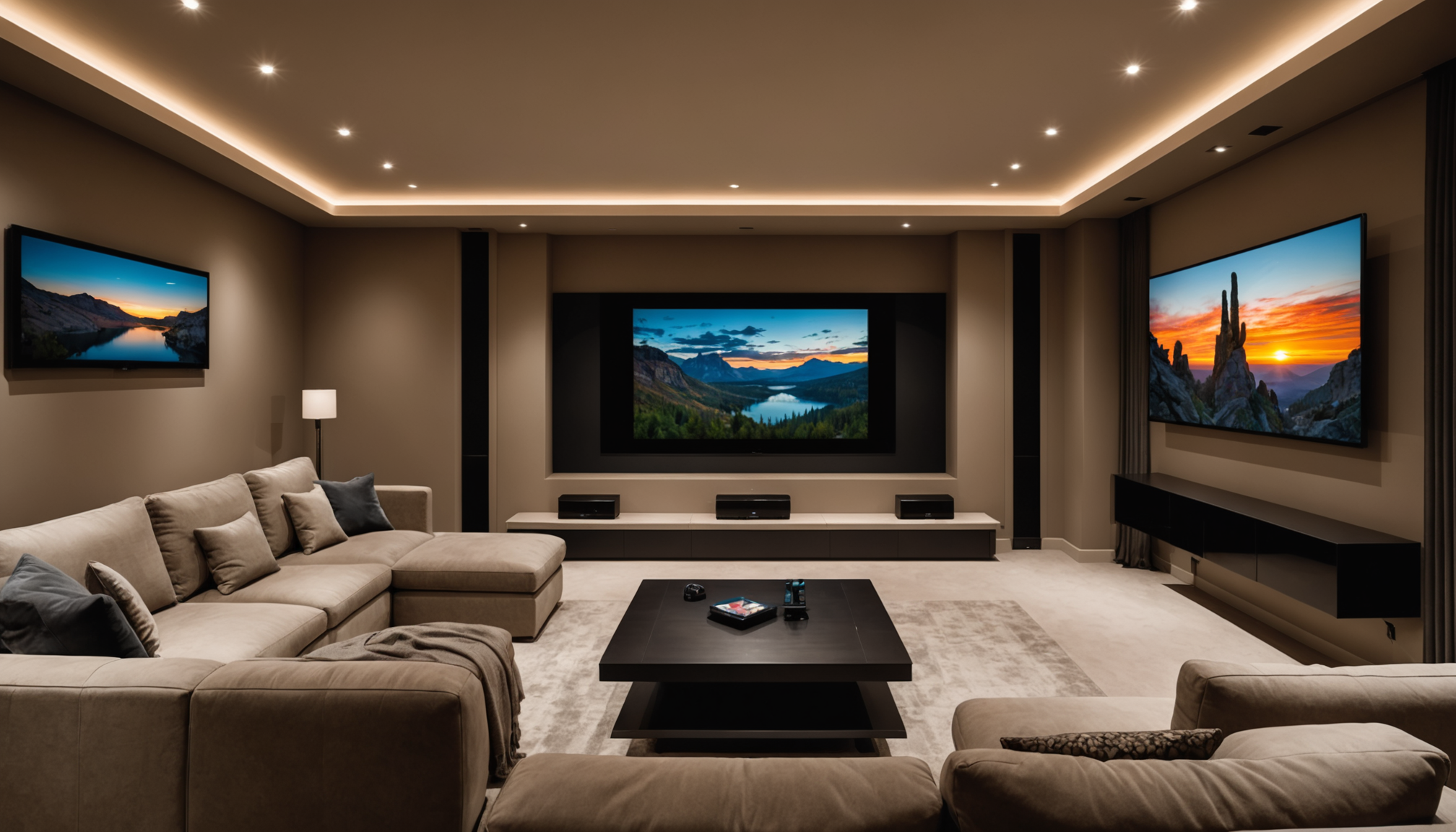When seeking help with audio/visual and computer setup services, it’s crucial to understand the range of offerings available. Whether you’re installing a sophisticated home theater system or setting up an efficient home office, service providers typically deliver a comprehensive suite of options designed to meet varying needs and budgets.
One of the primary offerings in the audio visual domain includes professional installation services for home theaters. This often involves configuring high-definition TVs, surround sound systems, and related components to ensure optimal performance. In addition, many providers offer customization options to tailor the audio-visual experience according to the specific layout and acoustics of your room.
In parallel, computer setup services focus on building an efficient and productive digital workspace. These services may encompass everything from installing operating systems and configuring software to setting up networks and ensuring secure connections. This is particularly valuable for small businesses or remote workers who require a seamless and secure computing environment.
- Installation and Setup: Includes complete setup of devices such as smart TVs, projectors, and computer workstations. This service ensures all equipment is correctly configured and fully operational.
- Troubleshooting and Technical Support: Provides ongoing support and troubleshooting for any issues that arise with audio/visual equipment or computer systems.
- Maintenance and Upgrades: Regular maintenance to keep systems running smoothly and recommendations for upgrades to enhance performance.
- Custom Integration Services: Designing a personalized setup that integrates various technologies and ensures compatibility across devices.
- Consultation Services: Expert advice on the best equipment and configurations to meet specific needs, taking into account trends in home tech advancements.
A comprehensive overview of service offerings often includes a comparison of basic and premium packages, detailing what each option includes and any additional costs. For clarity, consider the following table that compares typical service offerings:
| Service Type | Basic Package | Premium Package |
| Audio/Visual Installation | Installation of basic home theater systems, including mounting a TV and setting up audio. | Includes advanced customization and calibration for optimized sound and picture quality. |
| Computer Setup | Basic installation of computers and essential software. | Full network setup, data migration, and installation of specialized software and security features. |
| Ongoing Support | Email support and limited on-site visits. | 24/7 technical assistance and priority scheduling for on-site support. |
Understanding these service offerings helps clients make informed decisions based on their specific needs, be it an upgrade for their home tech setup or a seamless computer workspace installation. Knowing what each service encompasses and the potential costs involved allows one to select the most suitable option and maximize utility and satisfaction.
Pricing breakdown for audio/visual setup
When analyzing the pricing for audio/visual setup services, it’s important to identify the various components that contribute to the total cost. This breakdown will help you understand what you are paying for and why certain services might be more expensive than others. The cost of a professional audio/visual setup typically includes the following elements:
1. Equipment Costs:
– The type of equipment you choose can significantly impact the overall cost. Options range from basic models to high-end, premium brands.
– Costs will vary depending on whether you’re installing a basic home theater system or a more sophisticated setup with advanced surround sound systems and large-screen TVs or projectors.
2. Installation Fees:
– This includes the cost of labor for setting up the equipment. Depending on the complexity of your audio/visual setup, more time or expertise may be required, which can increase the price.
– Installation might also involve customizing the system to fit the room’s acoustics or ensuring integration with existing smart home technology.
3. Customization and Calibration:
– Advanced calibration can optimize sound and picture quality, tailoring the system to your specific room layout.
– Customization services often include programming remote controls, setting up lighting effects or screens, and fine-tuning audio systems for superior performance.
4. Cabling and Mounting:
– The cost here depends on the type and length of cables needed, as well as any brackets or mounts required to place equipment like TVs and speakers.
– Proper cable management is vital for both aesthetic and safety reasons, and professional services can ensure clean, concealed wiring.
5. System Integration:
– Integrating new equipment with your existing systems (e.g., smart home devices, gaming consoles, etc.) is often part of the service but can incur additional costs, especially if complex interfacing is required.
– Ensuring compatibility across devices guarantees a seamless audio/visual experience.
6. Post-Installation Support:
– Some providers include limited support in their initial setup package, while others may offer ongoing technical assistance for an additional fee.
– This support might cover troubleshooting, system updates, and maintenance to ensure everything continues to function optimally.
7. Travel and Miscellaneous Charges:
– Depending on the provider, travel fees might apply if the service is conducted in a remote location.
– It’s also wise to account for possible miscellaneous charges that can arise during the installation process, such as unforeseen modifications or additional components that might be needed.
Understanding the breakdown of these costs can assist you in planning your budget more effectively. By evaluating which components are most essential to your audio/visual setup, you can make adjustments that fit your financial plan while still achieving the desired performance and functionality. Make sure to request detailed quotes from potential service providers to compare these elements side-by-side and ensure that you’re receiving fair value for the services offered.
Cost factors for computer configuration
Planning for a computer setup involves several key cost factors that can significantly influence the total expenditure. These factors are vital to consider whether you’re initiating a simple home tech project or establishing a robust corporate workstation. Recognizing these components can enable you to manage your budget effectively, ensuring that you gain maximum performance from your investment.
One of the primary cost drivers is the hardware selection. The choice between entry-level components and high-performance systems heavily influences the overall cost. For instance, opting for the latest CPUs, GPUs, or additional memory can greatly enhance your computer’s efficiency, albeit at a higher price. Custom-build systems can be tailored to specific uses—whether for gaming, video editing, or general office work—allowing for only the necessary specifications and avoiding superfluous expenses.
Software and licensing fees also make up a significant portion of the cost. From operating systems to productivity suites, the type and number of software licenses required can add up quickly. Investing in reliable software solutions ensures a stable and secure computing environment, which is especially crucial for business setups that require extensive data handling and protection.
Installation and configuration services are another important consideration. If you’re not setting up the system yourself, hiring professionals to handle the installation can save time and ensure that everything is correctly configured. This service often includes installing the operating system, drivers, and essential software, as well as configuring network settings and ensuring that all components are working seamlessly together.
The network infrastructure is another critical component of the cost structure. Establishing a robust and secure network is imperative for both residential and commercial setups. The expense here includes routers, switches, network cabling, and other devices that ensure a stable and fast internet connection. Additional costs may arise for more advanced configurations, such as setting up a VPN for enhanced security or a server for file and data management.
Data migration and backup solutions can add to the cost. If upgrading from an older system, migrating data efficiently and securely is essential. Backup solutions, whether cloud-based or physical storage, provide data redundancy and protect against data loss, a crucial aspect of modern computing environments.
Post-setup support and maintenance are often overlooked yet vital components. Investing in a service that offers ongoing technical support can save money in the long run by preventing potential issues before they escalate. Such services may include regular software updates, hardware checks, and emergency troubleshooting, ensuring that your computer system remains reliable and effective.
Finally, it’s wise to consider peripheral devices and expansion capabilities. Monitors, keyboards, mice, and other accessories each add to the overall setup cost. Additionally, ensuring that your system can accommodate future expansions or upgrades—like additional RAM or improved graphics capabilities—can prevent unnecessary expenses later on.
By carefully evaluating each of these cost factors for a computer configuration, you can make informed decisions that align with your specific needs and financial constraints. This strategic planning not only optimizes your current functionality but also sets a strong foundation for future advancements or modifications.
Comparing service packages
When trying to decide on the right service package for either audio/visual setups or computer configurations, it’s essential to compare what different providers offer to ensure you get the best value for your investment. Packages typically vary significantly in both scope and cost, offering everything from basic installation services to comprehensive premium plans that provide extensive support and customization options.
Basic packages generally focus on essential installations and initial setup. For audio/visual needs, this could mean the straightforward mounting of a TV, connecting basic sound systems, or setting up a rudimentary home theater. Similarly, computer setup in a basic package might include installing an operating system and setting up primary software, ensuring the system is adequately functional for everyday tasks.
Premium packages, on the other hand, offer enhanced services that could substantially elevate the quality of the audio/visual experience and computer productivity. In audio/visual packages, premium services might involve detailed system calibration, personalized configurations to optimize room acoustics and lighting, and seamless integration with existing smart home technologies. For computer setups, premium packages typically cover advanced networking solutions, data migration, comprehensive software installations, and security configurations that meet specific business or personal needs.
One crucial aspect to consider is the ongoing support included in each package. Basic options often have limited service, such as occasional email support or scheduled check-ups, which might be sufficient for straightforward setups. Conversely, premium packages usually provide robust support services, including 24/7 technical assistance, priority scheduling for troubleshooting, and regular maintenance visits to ensure everything continues to run smoothly.
When choosing between these packages, consider your technical proficiency, the complexity and criticality of the system you’re setting up, and how much ongoing support you anticipate needing. If you’re installing a high-end home theater system with complex acoustics or a business-grade computer network requiring seamless operational uptime, investing in a premium service could be worthwhile.
Also, take a moment to compare hidden or additional costs often not immediately obvious in quoted package rates. Providers may add fees for travel, extended consultations, or emergency on-site visits. These additional costs can differ greatly between providers and may affect your decision.
To ensure you’re making an informed choice, visit LocallyFind.com, where you can explore a range of professional service providers and review customer feedback. This platform enables you to compare detailed quotes and services, helping you select a package that offers the best combination of features and value for your specific audio/visual or computer setup needs. Making a well-researched decision will maximize your satisfaction with the results and keep your home tech running at its best.
Additional fees and considerations
When planning for audio/visual or computer setup services, potential additional fees and other considerations can impact the overall cost and quality of service. It’s important to be aware of these factors to avoid unexpected expenses and ensure you receive the best value.
One such consideration is the possibility of travel charges. Some service providers may add fees to cover travel expenses, particularly if your location is remote or outside their standard service area. It’s vital to check if these charges apply when budgeting for your installation or setup.
Consultation services can also result in extra costs. While initial consultations might be included in some packages or offered at a minimal cost, more in-depth or specialized consultation services may incur additional fees. This is particularly relevant if your setup requires custom design solutions or involves advanced technical specifications that demand expert advice.
Emergency or expedited services often come with premium pricing as well. If you require immediate assistance or need services performed outside regular business hours, be prepared for a possible surcharge. This is a common practice among providers who must allocate special resources or technicians to address urgent requests promptly.
Warranty and service agreements are another area for consideration. Some basic packages might not include extended warranties or service contracts, which means that you might need to pay extra for protection against future issues or to secure ongoing support. Investing in service agreements can be beneficial to avoid higher costs related to technical support and repairs down the line.
Additionally, always account for possible modifications that may arise during the setup process. Unforeseen issues such as additional cabling needs, specific mounting requirements, or compatibility adjustments with existing equipment can lead to increased costs. Make sure to discuss these possibilities upfront with your service provider to minimize surprises.
Finally, some providers might charge for training sessions if you require assistance in fully understanding and utilizing the new setups or technology integrated into your home or office environment. If this is not included in the initial package, it should be considered in your budget planning to ensure you can maximize the usage of your newly installed systems.
By thoroughly understanding the potential for additional fees and considerations, you can better plan for a successful installation or configuration that fits your budget and expectations. This preparation is key to ensuring that your audio/visual and computer setup not only meets your immediate needs but also remains functional and efficient in the long term.
In conclusion, understanding the diverse offerings, pricing structures, and potential additional costs associated with audio/visual and computer setup services is key to making informed decisions that align with your needs and budget. By evaluating each element of service packages, comparing options, and anticipating any additional fees, you can achieve a high-quality setup that enhances your home tech experiences and ensures seamless functionality. This strategic approach will not only optimize your current setup but also provide flexibility for future expansions or adjustments, ultimately contributing to your overall satisfaction and efficiency.


